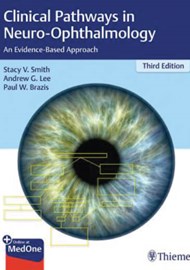This is a fairly comprehensive textbook with 20 chapters covering the most common neuro-ophthalmic problems you are likely to encounter in clinical practice.
The chapters each comprise several sections, the titles of which are often phrased as questions the reader may have (e.g. can the appearance of the optic nerve differentiate aetiology?) In the preface they mention their emphasis on using recent clinical evidence and it is clear that this is a well-researched book; there is a considerable amount of text discussing the findings of various studies and there is an extensive reference list at the end of each chapter.
When you first flick through the book it can seem a little daunting. There are no pictures so it seems like there is a lot of text. However, this is broken up with a wealth of boxes summarising key clinical information and also flow charts, which structure your thinking and approach to patients presenting with neuro-ophthalmic conditions.
The book reads very much like a review paper. It’s the first time I’ve read a textbook written in this particular style. For example, rather than just stating that recurrence of anterior ischaemic optic neuropathy (AION) in the same eye is uncommon and leaving it there, they then go on to explain the results of a study which looked into this. They also have tables which present the main findings from pertinent studies.
Now for some people this may seem like a little bit too much information. However, don’t let this put you off. The authors present the information in a succinct manner and it’s surprisingly easy to read through. They tackle difficult topics which aren’t often covered or are glazed over in general ophthalmic textbooks, e.g. supranuclear disorders of gaze. The authors remember to recap basic information such as anatomy, which makes it more accessible to juniors like me. As mentioned, there are lots of boxes which help you to find crucial information in a bullet point format which makes it easy to revise from. I found the chapters on diplopia and nystagmus / other ocular oscillations particularly helpful. I could finally get my head around two presenting complaints that I often dread seeing.
It is a very helpful textbook covering a difficult subspeciality and I personally found it an enjoyable read. It goes into the right amount of depth and gives you a deeper understanding than most books, whilst giving you practical advice on how to approach neuro-ophthalmic conditions.




